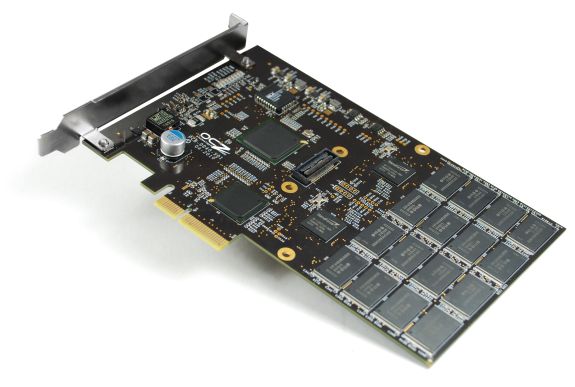OCZ Announces SandForce Based PCIe RevoDrive SSD
by Anand Lal Shimpi on May 31, 2010 10:33 AM EST- Posted in
- Trade Shows
- Storage
- SSDs
- OCZ
- Computex 2010
- RevoDrive
PCIe based SSDs have been reserved for enterprise use ever since their introduction. Generally limited by pricing, even OCZ's own forays into the PCIe SSD market have been targeted at enterprise customers. That may all change with today's announcement. Meet the RevoDrive:











32 Comments
View All Comments
zdw - Monday, May 31, 2010 - link
That connector in the middle of the board and the mounting holes makes it look like they could stack a daughterboard with additional controllers and flash onto this unit.devene - Monday, May 31, 2010 - link
pci-e x4 is still mostly used in servers... And that connector in the middle of the board is probably used for flashing the firmware.Samus - Monday, May 31, 2010 - link
no, i agree with zdw, it indeed appears to be a daughter-board interface. why would they have such a wide mounting area for a firmware update board and who would you need a firmware update board in the first place? it's PCIe, plug it in and the firmware update tool will find the device id, much like it would search the SATA channels. it is doubtful its a diagnostics port. however, if it isn't an expansion interface, it might not exist on the final product, either.ratbert1 - Monday, May 31, 2010 - link
I am thinking connector for battery/supercapacitor memory failsafe.johnsonx - Monday, May 31, 2010 - link
why would it need that? it's a FLASH drive.PedroDaGr8 - Monday, May 31, 2010 - link
I think he is correct. It is a battery port. If your remember anything about the sandforce drives one of their main features is that they cache more data to prevent excessive writing to the drive and get around some of the problems that were had in the past.Here is a quote taken from a blurb about a missing supercap in a consumer sandforce OCZ drive:
"...Its only enough for a short burst, but it's enough to get the job done. This is important on SSDs more so than HDDs in enterprise. On an HDD when write caching is turned off, the last write command is lost, but the rest of your data is secure. On standard SSDs because of the nature of Flash and Flash management it is not typically possible to guarantee data integrity on sudden power loss..."
bwj - Monday, May 31, 2010 - link
It makes no sense to use a 60-pin connector for a supercap.mindless1 - Monday, May 31, 2010 - link
Exactly, it is definitely not "only" a battery or supercap connector. Definitely a data bus with that many pins.A battery or supercap connector would just be unused solder pads or holes, or a standard low cost SIP connector already soldered on.
bwj - Monday, May 31, 2010 - link
Why would you need a 60-pin interface for a battery? It is almost certainly an expansion port for daughtercard. See also the Fusion-io ioDrive Duo.pkoi - Monday, May 31, 2010 - link
pci-e 4x being for server ? any 16x will do,almost all board have multiple pci-e slot or Have a look at old EP45-DQ6